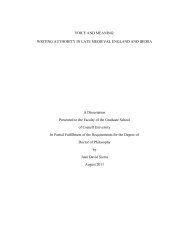Briana Anderson - Cornell University
Briana Anderson - Cornell University
Briana Anderson - Cornell University
You also want an ePaper? Increase the reach of your titles
YUMPU automatically turns print PDFs into web optimized ePapers that Google loves.
ut the study did not use a measure that was similar enough to classic Involvement<br />
studies to make the predictions in H3. 11 The study did measure what it intended to<br />
measure (personal closeness), but was incorrect in the assumption that this form of<br />
68<br />
involvement would act similarly to applied cognitive involvement advertising research<br />
studies. Rather, the results indicate that those who are more personally involved in an<br />
issue will more critically evaluate those with an attractive appearance in the case of a<br />
corporate social responsibility issue.<br />
Although there are several limitations of this study, the results provide insight<br />
that has both theoretical and practical implications.<br />
Discussion and Implications<br />
The findings in this study present several interesting findings with both<br />
practical and theoretical implications. First, in a practical sense, there is a positive<br />
relationship between endorser credibility and company credibility. Thus, the results of<br />
this study support H1. This is an important discovery as research has typically<br />
revolved around endorser credibility and organizational credibility separately, not the<br />
relationship between the two (as discussed on page 1). These results also indicate that<br />
a ‘halo effect’ occurs where people make judgments about a person’s credibility<br />
(endorser) and that those judgments carry over onto judgments of the sponsoring<br />
organization. The challenge lies in determining what factors create the highest<br />
amount of endorser credibility.<br />
Second, attractiveness may not behave as expected in endorser credibility in all<br />
endorsement situations. Hypotheses H1a, H1b, and H1c were not supported by this<br />
11 H3: In a high involvement condition, people will rely less on the physical appearance of endorser<br />
when making judgments about organizational credibility than in a low involvement condition. Thus,<br />
higher levels of personal involvement will result in a smaller difference in means of endorser credibility<br />
between attractive and unattractive endorsers.

















